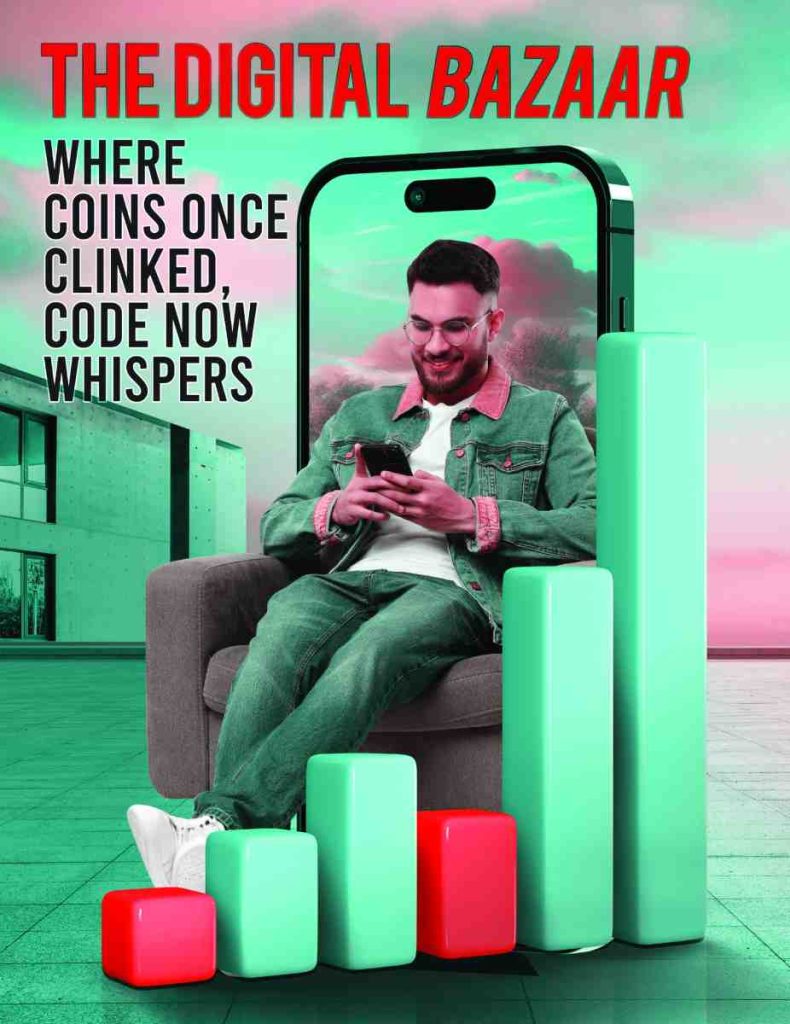As fintech continues to redefine financial behaviour in Pakistan, the traditional marketplace gives way to seamless digital interactions. This article examines how technology is reshaping trust, access, and user experience, highlighting the critical role of inclusive design, cybersecurity, and human-centric branding in building a financial ecosystem that is efficient, scalable, and emotionally resonant.
There was a time when money made music. It clinked in brass bowls, rattled in palm-lined pouches and sang its worth across noisy courtyards. It was loud, tactile and alive. Somewhere between the dust of the bazaar and the glow of a mobile screen, that music quietened. The marketplace, which was once a grand theatre of voices, colours and gestures, dissolved into lines of code. The bazaar still exists, but now it lives inside our pockets, behind passwords and beneath cold glass.
In the sunlit markets of the past, trust was built slowly. It was carved in every nod, handshake, shared cup of tea. You could smell the spice in a trader’s honesty and feel the weight of your rupees before you parted with them. Each coin changed hands like a story unfolding under the afternoon sun. Bartering, a dance full of rhythm, wit and mutual recognition. Money travelled at the pace of human connection, like a donkey ambling through dusty lanes or like news passed from one tea shop to another.
Today, the market has become invisible. A souk without stalls, a silent bazaar suspended in airwaves and algorithms. There are no shouts from vendors, no rustling of cloth, no haggling under the sun. Just icons in neat rows, passwords whispered like spells and digital wallets that never bulge. Currency now flows like water through fibre optic veins, unseen yet still powerful. Glowing dashboards now update in real time, replacing ledgers once inked in careful script, as anxious and immediate as a heartbeat.
Fintech initiators such as SadaPay and NayaPay here in Pakistan Revolut and Chime abroad are rewriting how we interact with our money. They promise speed, convenience and control qualities the old bazaar could never afford. With a few taps, you can send cash across cities, pay bills and save for emergencies all without leaving your sofa. Yet in their silent efficiency, something essential slips away.
Read More: Interview with Ramish Safa
Trust, which once lived in the eyes of a familiar shopkeeper, today flickers as green checkmark. We place our faith in biometric locks and encrypted networks instead of human warmth. Pages of terms and conditions have replaced the firm handshake, and faceless chatbots have replaced the friendly vendor. This shift is not inherently worse, but it can feel remarkably lonely.
That is why marketing and cybersecurity must work hand in hand to rebuild the connection. In the absence of touch, brands need to speak with genuine warmth and clarity. Companies like easypaisa have begun to understand this. Their campaigns feature real customers sharing stories of earning their first paycheques or saving for a dream project. They run workshops in schools and community centres to teach digital literacy and security basics. In doing so, they transform abstract services into human experiences and anchor trust in everyday lives.
Young people in particular are shaping this new market. Digital natives born with smartphones in hand expect seamless experiences, transparent fees and personalised insights. They judge platforms by their design ethos, not just their interest rates. Fintech apps respond with intuitive interfaces, gamified savings plans and instant alerts that speak their language. In this evolving landscape, youth are not passive consumers but active co-creators shaping features, feedback loops and social campaigns.
Despite rapid adoption, many are still left behind. The elderly, the unbanked, and the cautious find themselves lost in a digital maze. Without guidance, they struggle to download apps, navigate menus or recognise phishing scams. Rural communities often lack the network coverage and support services to fully join the digital revolution. In our collective sprint toward speed, we risk leaving too many at the starting line.
Yet, this story may be only its prologue. The bazaar is not gone, just waiting to be reimagined. We can blend the soul of the old market with the power of new technology. What if our digital platforms remembered how it feels to be seen? Or your banking app sent a gentle reminder on pay day or offered a virtual nod when you achieved a savings goal? What if security felt like a trusted guide rather than an impenetrable fortress?
The future of finance does not need to be cold or clinical. By designing with empathy, embedding ethical practices and weaving narratives that celebrate human hardship and triumph, we can craft experiences that are both seamless and soulful. Imagine a wallet that learns your preferences, buzzes with personalised tips and even surprises you with a digital voucher on your birthday. Picture a marketplace where virtual chat windows offer more than scripted responses but genuine listening and advice.
Because the market never died, it simply changed clothes from linen to light, and though the stalls may now be screens and the merchants’ avatars, the heartbeat remains unchanged. Trust, value, and connection, these are the oldest currencies of all. In this digital bazaar where code now whispers, the human need for trust still sings loud and clear.











